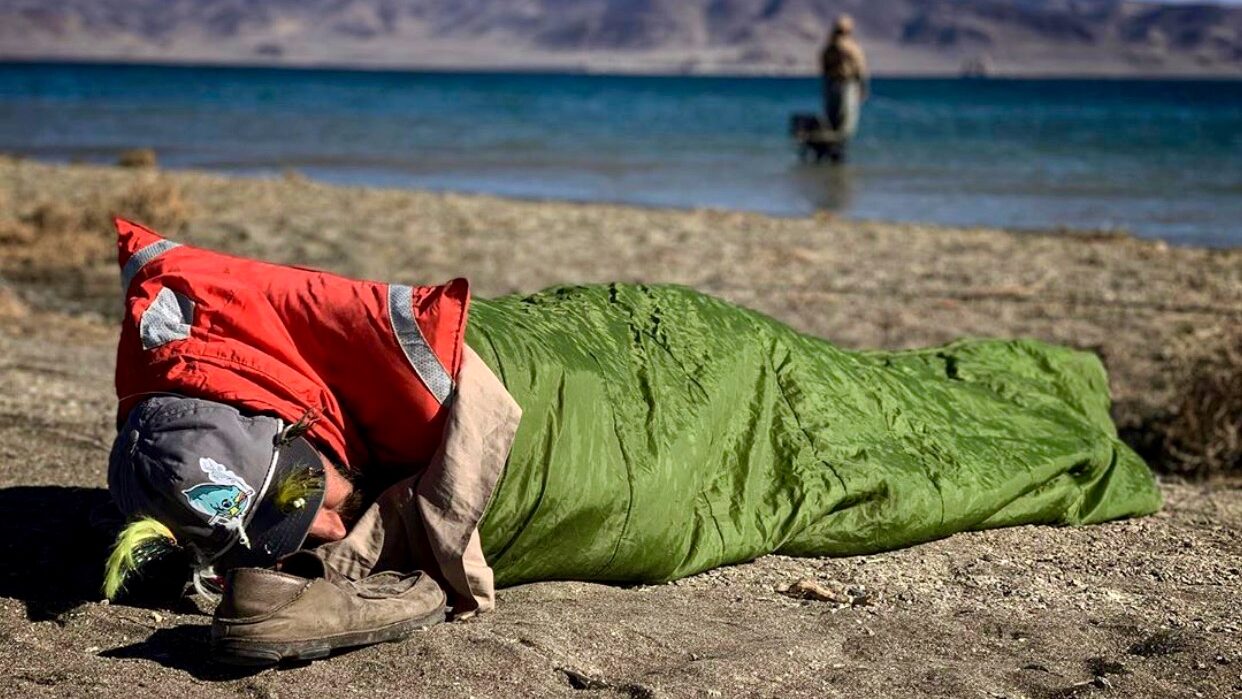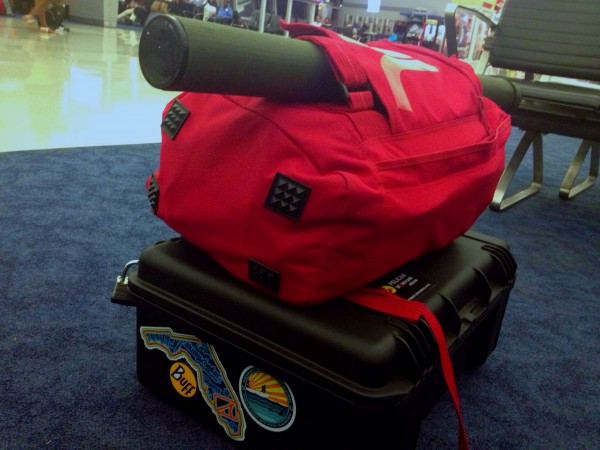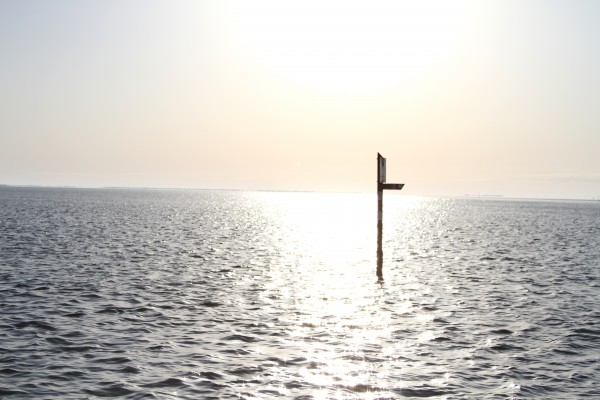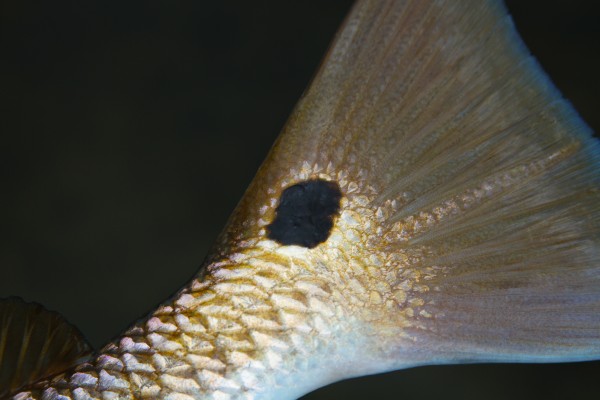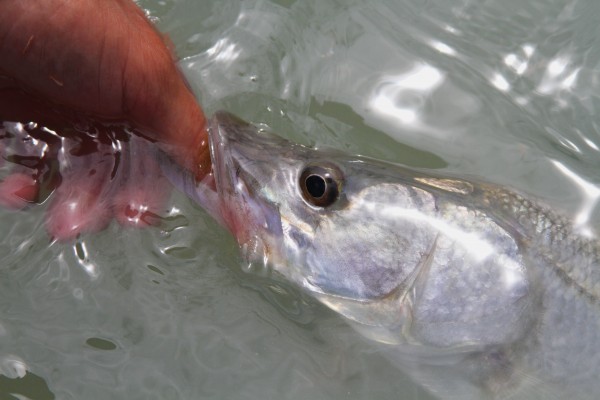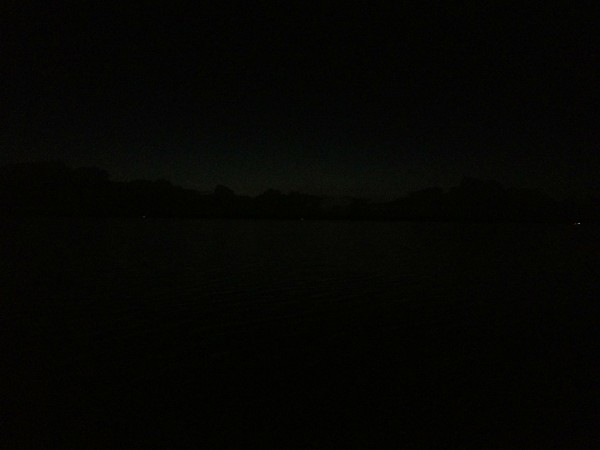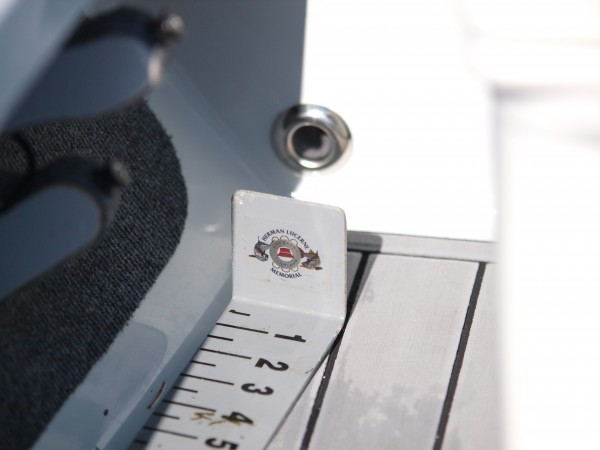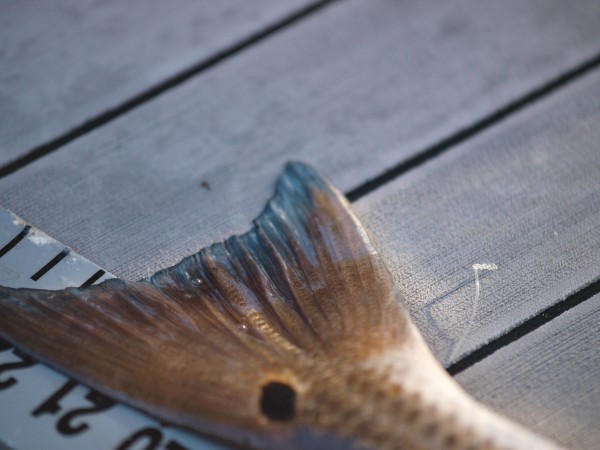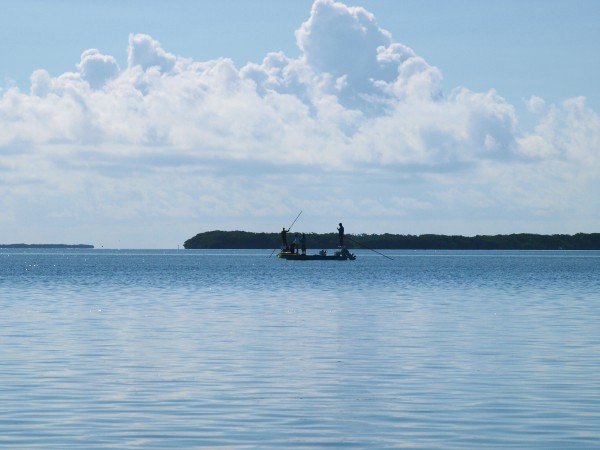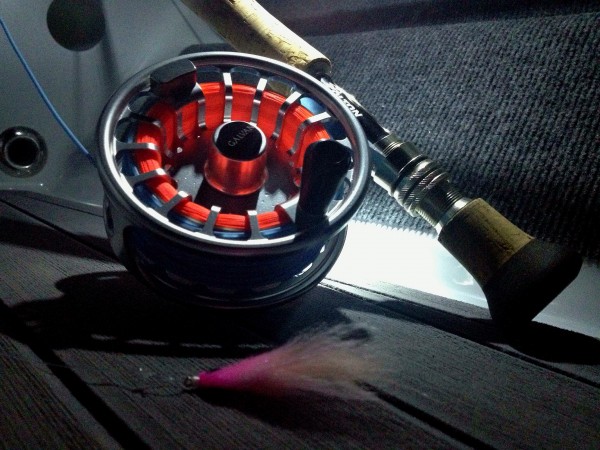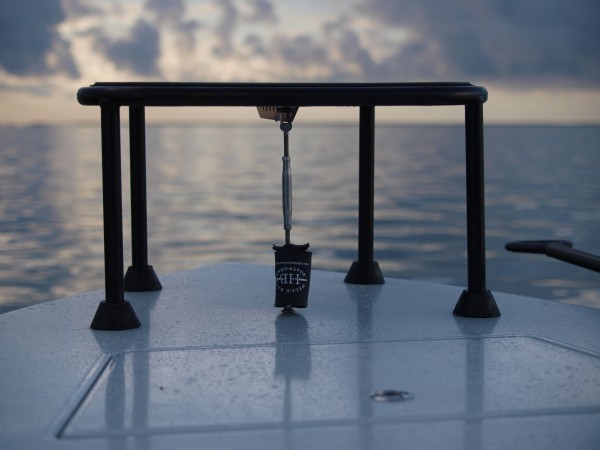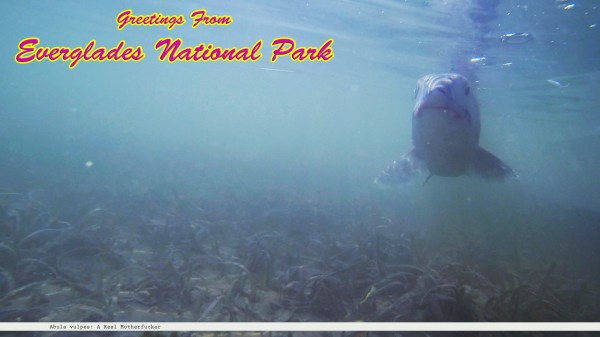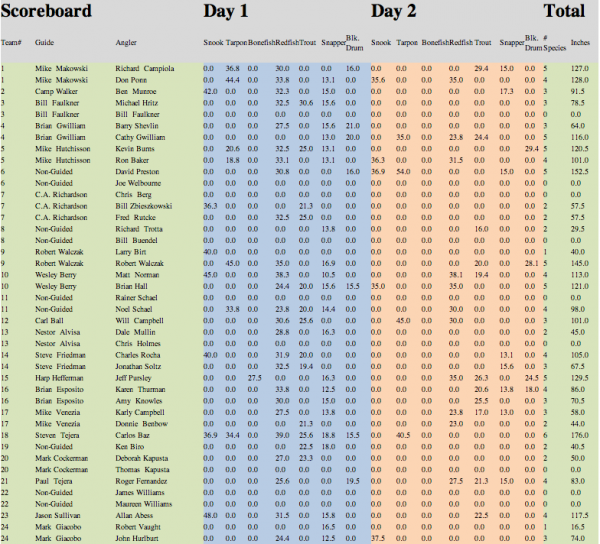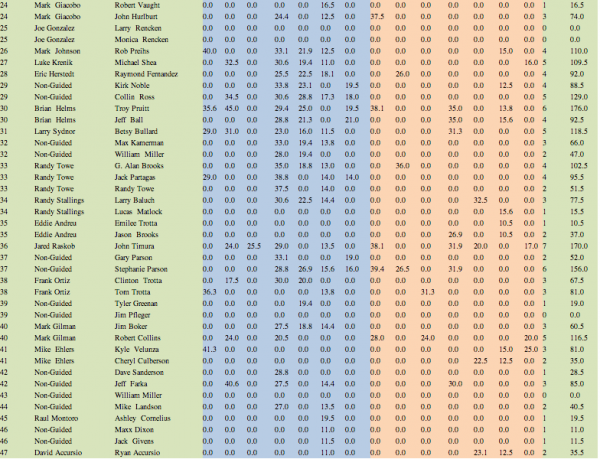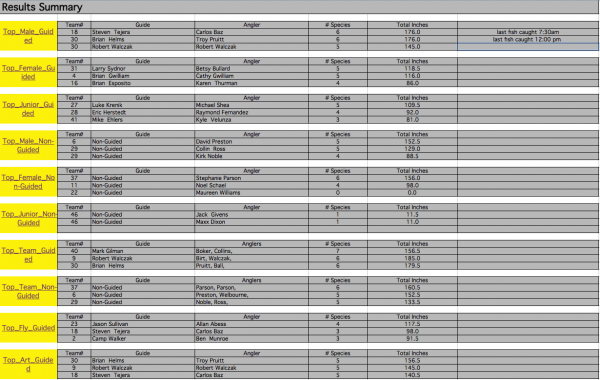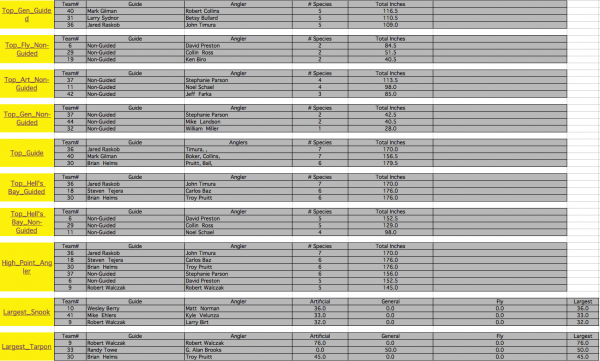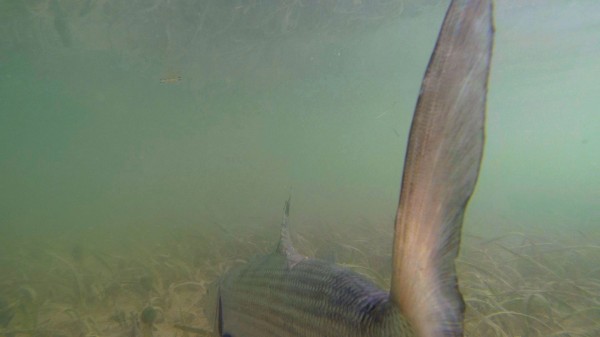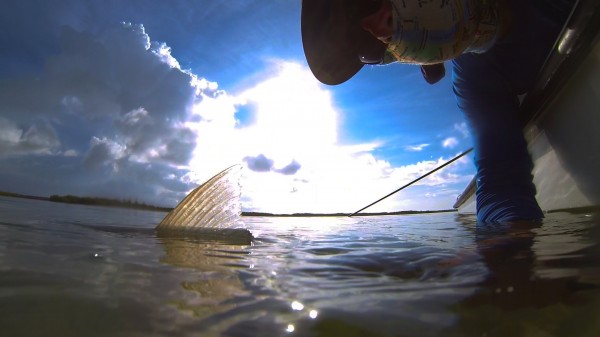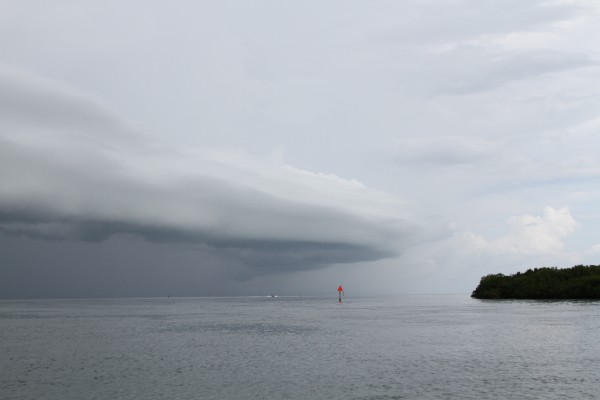I first learned of the Herman Lucerne Memorial about three and a half years ago. It was during the wee hours of a Monday night. Or a Tuesday morning depending on which side of the sleep cycle you may have been on. I was shivering at the bottom of a January cold front in my tiny radiatorless room, in a shared railroad style apartment on Avenue B, trying to warm myself against the freeze with a third bourbon neat and an internet’s worth of fishing web sites and blogs. I don’t remember where I found it. Some out-of-the-way forum. I just happened to stumble across some report from the 2009 Herman Lucerne. A few more clicks and I was staring at images taken on the water during the event. The awards ceremony. Then I found the tournament format. My adrenaline spiked. Two days to catch seven species. A pantheon of saltwater gamefish. Tarpon, sea trout, redfish, snook, black drum, snapper, and bonefish. By bait, spin, and fly. All within the confines of the angling Arcadia that is Everglades National Park. My immediate reaction was fairly straight forward:
FUCK ME. I’ve got to fish that tournament.
*
August 5th, 2013:
Deep, swirling bulkheads of miles high and quickly blackening cumulus ranged away in dark palisades all the way to Biscayne Bay distant to the east. With a foothold on the Everglades mainland the storms built tall into the firmament. The sun sat a blinding acropolis atop the tattered and slowly unraveling peaks of cloud.
Capt. Steven Tejera and I had spent the much of that morning throwing flies at snook and redfish laid up in some particularly skinny water. And in the windless forenoon, as the storms lifted skyward, the whole of Florida Bay mutated from an expanse of pellucid shallows into impenetrable mirrorglass. Unerring in its total recall of the sky, sun, clouds, and nothing else.
With clear skies to the south and west we started poling off the flat towards the channel and a chance to find unobscured water. And more fish. As Tejera pushed his Hells Bay across the flat we began to see tails popping up ahead of us. Short, grey and cropped across the upper caudal lobe, they chased slow, wobbling head wakes across the flat. More of the tails appearing. The grey swatches unmoving where they stood above the waterline.
I sent a few half-hearted loops in the direction of a few of the drum that appeared within range. One of the fish tailed down on the fly. Not to eat it, but rather, to watch the neon curiosity swim past.
I looked back to Tejera.
“Get one, dude.”
I handed him up a spinning rod rigged with a soft plastic shrimp imitation impaled on a jig head.
Black drum have become a running joke between Tejera and I. Last year, right before the Lucerne I passed a rod up to the poling platform and watched him play a skimmer jig across the nose of black drum. A move that resulted in one of the more exciting top water eats I’ve had the pleasure of witnessing.
This time was no different. Tejera tried three fish before sticking a hook in number four. A solid fish.
The drum was very dark. Banded with black and light black. The fish wore a half-dozen muddy barbels at its chin.
Tejera cradled the drum in the tannin rich water as it got its wind back.
“That’d be six in Lucerne,” I said.
The day before we’d managed a tarpon, snapper, trout, snook, and redfish. All on fly.
Tejera looked back at me and smiled.
“Hell yeah, bro! We’d be doing really well.”
The drum swam off and Tejera sat up into the cockpit. He wiped the water from his hands onto his shirtsleeves.
“You fishing with the same dude again this year?”
I had to ask.
Tejera was quiet a moment as he watched the storms rising behind us.
“Yup. We’re excited.”
“Fuckin’ A. I bet.”
Tejera was quiet again.
“Yeah, he’s actually got a baby on the way. It’s due that weekend. I was talking to him about it. He’s not sure if he’ll be able to make it. He thinks he will. He should be able to. But, fi he can’t, I wanted to know. Would you want to fish the tournament?”
I considered the offer for a moment. A very short moment. It wasn’t the first time I’d been on the second team and I knew well enough that even a long shot is better than no shot at all.
“Absolutely.”
Tejera nodded.
“Say the word and no matter what I’m on the plane.”
“Awesome, dude. I don’t know if it’s gonna happen, but I’ll let you know either way.”
*
August 19th, 2013:
My phone started buzzing around 6pm. The dining room of the restaurant I manage was half full and I had just sat a lovely couple at the bar. I saw Tejera’s name on the screen. I was halfway to the front door before I remembered to tell my colleague that I absolutely had to take the call.
Anyone watching must have thought I was in the midst of receiving terrible news. I paced. My free hand was alternately raced through my hair and clasped over my mouth. I nodded very slowly. My responses monosyllabic. And when I ended the call I just stood there. Taxi’s ran a yellow streak up Third Avenue. Nine-to-fivers maneuvered past me.
With a baby expected on the second day of the tournament it would be too risky for the other angler to fish. He was out.
I was in.
*
Friday, September 20th, 2013
When I boarded my flight to Miami International Airport, twenty-five hours before lines in at the 2013 Herman Lucerne Memorial, I was functioning on the mere five hours of sleep I had managed more than a day before. And between driving straight to the Everglades to get in a few hours of pre-fishing, driving back out, getting checked into the hotel and prepping for the next day, I had another fifteen or sixteen hours to go before I would have a chance to recharge. But I was on my way to the Everglades and the Herman Lucerne. Sleep would have to wait. Because the fish would not.
Just after 11am Tejera and I were motoring out of the Flamingo marina. There were a few doors that we wanted to knock on. See who was home. And so we set out, headed into one of the fishiest environments on the planet, to not necessarily catch fish, but to simply see them.
Oh! The sacrifices we make.
We spent the first two hours patrolling an area that had produced well for us a little over a month ago. We found a sizeable snook floating high and warming under the afternoon sun. The viridescent shoulders brilliant in the crystal bightwater. Small dimples in the wind stroked riffles where the round peak of its caudal fin pricked the surface. I threw a loop at the snook. She wheeled on the small, orange fly and looked at it, but wouldn’t commit. We didn’t take another shot. Tail sweeping easily, the snook swam towards the middle of the flat. Her grey shadow keeping pace and flaring in strange distortions where it rode over small hillocks in the pale bottom.
Further down the flat a redfish, black with contrast where it floated up in the middle of a pothole, fell victim to a few short strips of the same fly that the snook had refused.
We stayed a short while longer, working our along and finally off of the flat. Sorting out a few more fish from amongst the stir of shadows atop the turtle grass. The long corridors of mud bottom. We saved our casts. Lest we come tight to a fish that would be better caught on the day following. No sense in capitalizing on any benevolences the otherwise indifferent universe might have offered us. No points for fish caught on tournament eve.
As the day wore into late afternoon we ferreted amongst ladyfish and jacks in search of seatrout. Some time was spent rehearsing the rather difficult technique of releasing ladyfish from the hook at a distance of forty feet or more. By the time I had just about perfected maneuver we found the trout. After a few quick releases and a pin drop on a digital map, we were again on the move.
Our last stop of the afternoon was a quick one. Long, probing casts down range of the skiff resulted in another redfish and a fine snook that came aboard with scales radiant and undimmed by the tannic water. Scales sparking as though they had been gilded with zinc.
After releasing the snook we took a moment to asses.
“What do you think,” asked Tejera. “Should we go look for bonefish?”
I shook my head.
“We could find fifty of ’em today and zero tomorrow.”
Tejera nodded.
“We know where they should be, right?”
“I know where they’ll be.”
“Then let’s cross that bridge when we get to it.”
Tejera sat down at the helm and keyed the Yamaha to life.
“And when we find them,” he said motoring us up to a high idle. “We’re gonna crush them.”
“Fucking right we are.”
*
Driving out of the park that afternoon was a challenge. Sleeplessness had begun to pollute my senses. I nearly made a speed bump out of a turtle that had managed to cross both lanes of traffic unscathed, and I almost plunged the rental car into the roadside swale twice. To fend off catastrophe I was reduced to playing the radio at near full volume and scream-singing along with whatever happened to be playing. Not surprisingly, Sugar Ray is still terrible. At any decibel level.
Needless to say, I was absent from the HLM kickoff party in Islamorada. Trading it instead for HBO, a cold beer (that I immediately spilled upon falling asleep), and dreams of jerkbaits and 8-weights.
Saturday, September 21st, 2013

Tejera and I arrived for check-in at Don’s Bait and Tackle in Homestead a little after 4am. We were the second team to turn up. A third and a fourth team arrived before we’d finished putting ice in the cooler. Anglers and captains alike were all in good humor. Introductions were made. Pleasantries were exchanged. Jokes were told. Mention was made of how many foot pounds of torque belonged to a specific truck engine and that no attempt to pass it should be made.
A fifth team arrived and joined our cabal. The lot of us were gathered around Tejera’s skiff. Forearms rested along the gunnels. Hands clasped together with fingers interwoven. All of us chatting idly and low, with our heads slightly bowed and eyes fixed not on the others in attendance but the grey deck of the skiff. Acolytes of a fanatical sect uttering quiet invocations at their slim fiberglass alter. The ritual instruments stowed along the flanks of the boat gleaming in the artificial light. A truck towing a flats skiff sailed through a traffic light and made a slow turn into the parking lot. All of us silent and watching as the truck was steered to a stop.
With half-a-million dollars worth of flats boats bivouacked in the parking lot the group broke apart and headed into the tackle shop.
The mood remained light and the young men left in charge of the shop, eyes bleared and red with lack of sleep or cheap beer or both perked up, and made conversation with the contestants as they underwent processing by tournament official Scott Giberson.
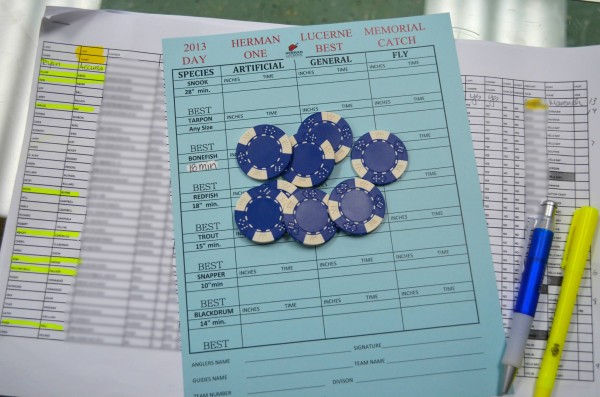
Look pretty for me. That was the directive Giberson issued as he brought captain or angler forward to photograph them with the days chip and scorecard. A tall order for some in the motley crew of fisherman present. More importantly though it proved to be a pleasant moment of levity on a day that would become increasingly tense for all involved as time wore on.

Checked-in, we wished Team Hell’s Bay luck and headed for the truck. It was time to turn our attention to the business at hand. Attempting to win the Herman Lucerne.
When 5am came, it wasn’t exactly a shotgun start, but a calvacade of hulking pickup trucks with skiffs in tow, tearing down US-1 at seventy-five miles an hour through the hush of a still sleeping homestead and off into the black west must have been something to see.
Conversation between Tejera and I during the drive to Flamingo was kept to a minimum. Our game plan had been set a day before. We knew where we needed to be and when. As we blasted along the sun drenched bitumen that is the Park road, discovering bone white out of the darkness beneath our headlights, we took the time to relax. To think slowly and to focus. All that remained was the execution of our strategy. Tejera and I had fished together enough hours and enough days over the last few years to know each other’s resolve instinctively. And to know that no matter what situation arose, our reactions to it would be reflexive and without hesitation. In the end it comes down to trust and nothing else. And when you are in possession of such a thing as trust, there are no words that can better state the fact. We would fish the way we always do. Deliberately and calmly until we caught our fish. Short though the fishable hours were, they would prove to be enough if we stuck to our plan and simply fished.
Tejera dropped the skiff with Team Hell’s Bay right alongside of us. I raced the truck into a parking space and emerged from the cab at the same moment that Capt. Wesley Berry was disembarking from his truck. I started for the ramp at a trot. Berry stepped lively to match my pace. At the sound of his footfalls I broke into a dead sprint and Berry followed suit. The two of us speeding head long toward the ramp and clambering down the dewslick gangplank and alighting onto our respective skiffs at a leap. The engines throttled in unison and both skiffs lurched toward the small inlet at the mouth of the Flamingo marina basin.
On clearing the marina, Tejera hammered the throttle forward and the skiff vaulted onto plane and sent us careening off into the dark. Orion ruled the eastern sky and with bow outstretched he threatened the great globe of the moon where it rode above us full and unobscured in the infinite black of the rotunda. Before us, lay Florida Bay. The expanse of it unmoving and japanned entire with the pale, rimy light of the moon.
Behind us the mechanical bellowing of Team Hells Bay’s engine echoing out from the cowling.
The glow of Team Hells Bay’s bow lights began to grow and grow at our rear. Before long they were less than a cast away and still gaining ground. Another minute and they had drawn even with us. They raced along at our port side. A wash of salt spray flinging skyward between the two hulls. All of them wrapped in moonlight, teeth luminescing through dark smiles that widened around laughter and jeers. We answered with high whoops and more laughter.
Ultimately, Team Hells Bay passed us by and continued on towards morning. We tracked along behind them for a time, watching the blue serpentines of their wake veering through the gloom across the black water in search of the channel, until we made the turn towards our first destination. The whine of their outboard growing more and more faint until it altogether was silenced by distance and all that could be seen was the wink of their bow light coursing along through the dark like some celestial body knocked from its parabola and carving along an aberrant trajectory on its way into eternity.
*
Before one actually competes in the Herman Lucerne, one must understand the scoring. It is fairly straight forward and is as follows:
1″ = 1 point for any species caught on natural bait.
1″ = 1.25 points for any species caught on an artificial lure.
1″ = 1.5 points for any species caught on fly.
Species trumps everything. If you have most species in any category you win. Period. The end.
After species comes points. If your species total is equal to another’s in any category, then whoever owns the most points wins.
In the event of a tie of points, then whomever caught their last species first will be declared the winner.
You get the gist of it.
There are other rules regarding how many species you must catch in order to be eligible for which awards, methods, leaders, boundaries, etc. Most of it is boiler-plate, though still very important, and can be found here.
*
Two low blasts from an air horn reverberated across Florida Bay at 630am. The vessel of their origin unknown. There was still only moonlight to fish by. I sent my first cast of the tournament off into the darkness of 12 o’clock and Tejera started poling down the flat.
We had not gone very far before we began to hear the gurgle and slap of rolling tarpon. I fired the jerkbait downrange in the assumed direction of the fish. Nothing. A few more probing casts. Still nothing.
As the gloaming filtered over the sawtoothed mangrove horizon, and bled out across the bights, cayes, channels and flats of Florida Bay we could see the tinplate scales of the tarpon flashing as they rolled through the tenebrous light. We closed the distance. A pair of them were waking their way across our bow from 10 o’clock. I made a cast. The lead fish surged and tried to eat the jerkbait but never got it in his mouth. Both fish spooked.
Another five minutes passed and we had more tarpon coming in at 7 o’clock. Tall dorsal fins cleaving small slipstreams in the still water.
The thought of breaking out the fly rod and laying down some fur down in front the advancing poons occurred to both Tejera and I, but we left the Colton stowed. Our plan was to start with the jerk bait and to stick to it. Not to deviate in the first half an hour from what we’d spent a week planning. The fish were there and the shot was ours. I got the cast out in front of the lead fish. I started the jerkbait twitching back towards him. The poon ate and went airborne. A few short runs and handful of jumps later and he came over the gunnel.
659am.
We were on the board with a 27.5″ tarpon. Twenty minutes later we logged our first trout.
With less than an hour of fishing time elapsed and already plenty of slime on our stick to show for it, we changed locale and turned our focus to finding a snook. The fish that Tejera and I had decided weeks before would be the most difficult fish of the seven species to catch at the eligible size.
And here’s why:
The minimum qualifying size for a fish that may be entered in the Herman Lucerne is equal to the minimum size for recreational harvest as set forth by the State of Florida. Granted, it’s a catch and release only tournament, but you still have to meet those same minimum harvest requirements for any fish that you enter, save tarpon. The minimum size for a harvestable snook was increased this year from twenty-four inches to twenty-eight inches.
A twenty-eight inch snook is not a monster. However, a twenty-eight inch snook is still a damn good fish. And one that puts you well beyond the range of a fish that can caught with any reliable frequency. If you snook fish, you know that 18″-24″ snook are more easily had than those snook that push the 28″ mark. A size where, especially in super skinny water, snook are smart, spooky, and much, much less eager to do anything but throw up a huge head wake as they tear, with no clam, across the flat in the wrong direction.
Let’s have some fun with numbers and put the 24″ minimum for snook versus the 28″ minimum into a human context in terms of age. What many regard as the defining factor in acquiring enough wisdom to function (relatively speaking) in that awful, dreary realm known as the real world.
Cursory research revels that snook will live to be roughly 18 years of age. Barring catastrophe, of course. American humans currently have a life expectancy somewhere in the neighborhood of 79 years of age. 79 divides into 18 a total of 4.39 times. So, to get snook onto a human timeline for life expectancy we will use that number 4.39.
A 24″ snook is approximately 4 years old. Multiply 4 by 4.39 and we get 17.56.
A four-year old snook finds its human equivalent in a high school senior.
A 28″ snook is approximately 6 years old. Multiply 6 by 4.39 and we get 26.34.
A six-year-old snook finds its human equivalent in a fully grown adult.
Consider how difficult it would be to convince someone not even old enough to buy cigarettes to take part in some really, really stupid shit that could end with major, possibly life-threatening consequences.
Okay. Good.
Now consider how difficult it would be to get someone with a job, bills, a home, and quite possibly a family, to take part in some really, really stupid shit that could end with major, possibly life-threatening consequences.
See where I’m going with this?
Oh, yeah. Don’t forget that the snook we needed to catch, fish of 28″ or more, would have had to survived the catastrophic freeze of 2011. Meaning they’re really smart, careful, AND lucky.
In summation, fooling old snook is hard. In any situation. Let alone a must catch situation with a ticking clock. Needless to say, the entire field had their work cut out for them.
We poled onto the flat. The weighty, hollow suck of snook feeding at the surface sounded off ahead of us and at various points of the clock. I started casting in the direction of the eats. To potholes. Blind where the glare rendered us sightless. It took about ten minutes.
The jerkbait stopped dead in the water. I swept the rod and drove the hook point. In a rush of water the snook breached headfirst. Gills flared. Rattling like coins in a coffer. The snook rose vertically from the water. Pectoral fins flared and mouth agape the fish began tailwalking towards us. Some elongate and bleached bird of paradise warning back transgressors.
Tejera and I looked at each other.
“That’s him,” said Tejera.
“It’s gotta be.”
A few runs and another pair of jumps later and we had the snook in the net.
We put the fish to the stick. Tejera rose from his crouch and stepped back. Shoulders a little slack.
“No.”
My hands were clutching the top of my head. I did not remember putting them there.
“Come on.”
The snook taped out at 26.5″.
As we released the snook neither of us could help but laugh. Both Tejera and I had, for that brief moment upon seeing the fish, allowed the notion that this particular exercise had been made easy to creep into our heads. We knew better. Still, it had proved amusing to entertain the thought.
With our resolve intact, we kept fishing.
Cast after cast after cast we fished a winding course across the flat.
Nine more snook came to hand. All of them short of the mark. Twenty-two’s. Twenty-four’s. A twenty-five.
On hooking fish number eleven my breath caught. The fish made a long run and leapt at the end of it. Cartwheeling across a pothole. The early sunlight scrambling its pale belly into white pixelation.
That fish taped out at 27.5″.
This is the point where we could have abandoned the snook and our game plan, gone on to target another species, finally returning to chase linesiders at a later time. But what later time would there have been? When we would we be this covered up with snook again? Seventeen hours of fishing is all you’re afforded and it’s no time at all.
We kept working. Fifty yards later we saw the head wake coming in from our left. I let a cast go out towards 11 o’clock. Twitch. Twitch. The tannic main crackling as it split under the force of snatching jaws. I came tight and the fish rolled at the surface. The bright orange soft dorsal, stretched down the rear of that ruddy back, cut above the water as it boiled.
I will never complain about catching a redfish. Ever. I didn’t complain about this one either.
At 23″ the redfish gave us another species and boosted our point total up. Three down, snook still to go.
Tejera and I had just released the redfish and were both still in the cockpit regrouping when we saw the snook eat a hundred feet ahead of us. Black of the back and shoulders we watched the fish climb out of and over the water only to recommit itself to the brine in a hammer stroke that fell upon whatever mark it had chosen. Its shoveled maw wide and gaping. Tejera poled us in range. Nervous water where the fish had settled. I fired a cast that fell adjacent to the swollen, yellow eyes. As the jerkbait came bumping and grinding before the snook, the water behind it swelled half a foot as the snook the gave chase. The pot, pot, pot as it tried to siphon the bait from the surface. With a single wipe of its tail the snook surged and flushed the square foot of water in which the jerkbait swam between its jaws.
What an eat.
It was a tense few minutes. There was belly-rolling. The peal of the drag as the snook hared across the flat. The bony ditch of it flared skull thrashing at the surface. Mid-air gyrations that the saw the snook craning its back into shallow oxbows with its flanks atremble .
If you were within five miles of us when Tejera brought the net up underneath the fish, then you would have heard us screaming. It was right around 9am.
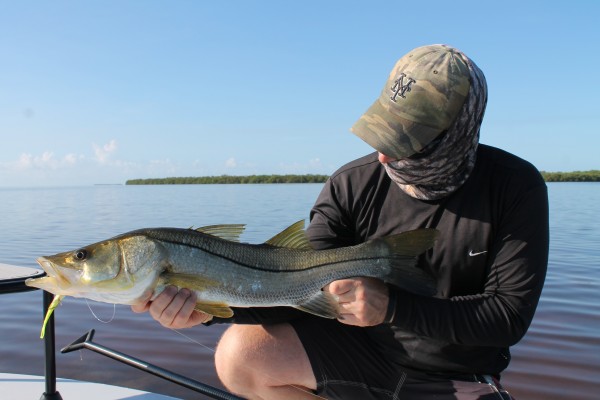
At 29.5″ it was all the snook that we could have hoped for.
Tejera had the engine cranked and was motoring us off the flat before the snook had even swam from sight. The yellow peak of its tail slowly whisking at the surface.
A quick check of the tides told us that we had a solid window opening for a shot at a black drum. A species notorious for being rather meddlesome during the Lucerne.
*
Our first stop on the hunt for drum, though providing us a front row seat to the magic that is filming outdoor television, did not yield even the first glimpse of a drum.
We changed venue and resumed our search. No fish. After a time, it seemed as though we might struggle a bit in finding our ugly, barred quarry. Than all at once we found ourselves surrounded with life. The sheepshead showed up first. We came upon a few cruising redfish. Another laid up. Snook lifted out of nearby potholes and moved off warily. Then the drum appeared. Their wan shadows searching clumsily over the turtle grass.
I flipped a live shrimp to single fish staring idly into the verge below him. The fish turned and tipped down onto the shrimp. I came tight and the hook shot out of the water back at me.
I went tight all over. Balled my fists.
“Don’t sweat it,” Tejera coached from the platform. “Get a shrimp. Quick. You’ve got more fish coming in.”
A pair of drum came lumbering in at 10 o’clock. I landed the shrimp ahead of the larger of the two fish. A thump rolled up the braid. I didn’t move. I just let him eat. When I set the hook the larger drum bolted away towards the stern. My line, however, shot off towards the bow. The smaller fish had found the shrimp first. Reckless youth.
Even though it was not the fish I had gunned for, it was a black drum. And at 15.5″ it counted for species number five out of seven. Only bonefish and snapper remained. It wasn’t even noon.
With a good bit of time remaining before the tides would be at the appropriate stage for finding bonefish, we made a stop on a deep flat to see if we couldn’t score our snapper and upgrade our trout in one fell swoop. Dredging with a soft plastic jig was enough to get an eligible snapper into the skiff within the first ten minutes.
Count it. Six species chalked up and we were barely beyond the midpoint of the first day.
Over the next hour we fished the deep flat as hard as possible looking for a trout larger than the one we’d picked off that morning. A constant deluge of ladyfish hindered the jig from reaching that perfect zone where the trout like to hunt. Ladyfish after ladyfish cartwheeled across water. Shimmering. Metallic. The jig careening off at random. Small jacks found their way to us. Eventually we got into trout, but after three fish in a row that failed to eclipse the 15″ mark and time carrying us quickly towards the tide change we needed for bonefish, we had reached a moment of decision. Stay and keep working on the upgrade or go and chase bonefish.
In the end we split the difference. The call was made to stay another fifteen minutes to work on the upgrade. Then win, lose, or draw we were going bonefishing.
Fourteen minutes later, a trout reared out of a white hole twenty feet away from the skiff and smoked the jig as it fluttered down toward the seagrass.
The trout taped out at 20.5″. A solid upgrade.
We turned the trout loose and turned the bow south.
Though it was obvious going into the event how important time management would be, it was slowly revealing to me that fishing along a razors edge was an absolute necessity. Not even a single minute could be wasted.
*
We arrived at the first bonefish habitable flat to find the tide well behind in turning and still coming in. It showed little sign of switching. High water ruled. We stayed a moment on the brink of the flat. The colorless tide heaving against our hull. Visibility was high and we could see well ahead of where we had paused. A few short minutes passed and not even the first sign of life, save the tousling seagrass, revealed itself to us.
“We gotta look,” said Tejera. “They could still be here.”
A pair of leathery, grey bonnethead sharks were the first fish to show. They rode up the slick, yawning wide and quartering from bow of the skiff. Cut from the tide by the narrow keel. Their wide heads wobbling as they struggled to make sense of our shape before continuing on through the shallows.
We fished that same flat for an hour and then some without seeing another fish. Garbage or otherwise. Tejera spun the bow towards the channel and levered hard against the pushpole. Water sucking at the transform as the skiff eased along.
While it would have been some feat to set precedent and notch an eligible member of all seven species in a single day, and on an actual tournament day no less, the bonefish just wasn’t going to happen that day. And with the entirety of day two remaining, there was still plenty of time left to focus our efforts on bringing a bonefish to hand and victory along with it.
Idling along in the channel that rimmed and ran nearly a full circuit around the forsaken flat, we deliberated over how to spend our remaining time. Our current point total was high. It was respectable too. But there were still quite a few points to be won with the fly rod.
Tejera had eyes on two locations. First, we would sight fish a nearby flat that had been holding good numbers of large redfish over the last week. Then we would end the day trying trick a snapper into eating a bit of craft fur.
*
I took my shoes off and stowed them in the cockpit and retrieved the 8-weight Colton from beneath the gunnel and ascended the casting platform. I pared line from the reel onto the stripping mat. The short zipping of the drag. Tejera and I were silent as we moved onto the flat. Constant in our auguring of what lay before us.
Tidewater sluiced over the shallows. Combed backwards under the weight of the flow, the whole of the turtlegrass lea revealed the dull, peaked algae flourishing on the underside of every last blade that belonged to those miniscule depths upon that shelf. Rays searching atop the grass. Their gait unbroken. Rain bait blurring the faultless sweep of water. Everything present but the thing itself.
Fifty yards further up the flat we came upon the fish. Swaddled in the swaying verge and clad in a scaled mail of glowing vermeil, the redfish lay motionless beneath the vernal sun. I let the small, damask baitfish fly fall from my fingers. I loaded the Colton with a pair of false casts and sent a loop downrange. The fly settled a foot aft of the fish. Behind its head. I carried the tip of fly rod away to the right, repairing the line to the shape of the current. Caught up in the tide, the fly began to swing. Washed clear of the redfish I made a long a strip and slid the fly just before its blunt snout. Quitting its repose, the redfish wheeled on the fly. Charging hard and pushing a limpid drum before its skull. I stripped again. The fish surged. Salamander eyes afire. Gill plates distended with the crystal brine and the pale trestle of its jaws fully dilate, the redfish bolted down the fly. A havoc of foam and water churning with the hiss of ignition. Switching its lower half violently the fish raced across the grass. The line cleared. Racing through the guides and coming to against the drag in sharp report as the last loop chased the redfish and careened against the carbon fiber just above the cork handle.
Its deep tail torquing heavily the redfish made short, powerful runs. Head-butting fiercely in attempt to reach the deeper raceway cleaving the flat. The fish rolling and thrashing in crocodilian fashion once there. Few are the redfish that will not fight you nearly to their death for every last inch of line.

When the redfish came to hand an extraordinary sense of fulfillment came over me, despite the fact that little out of the ordinary had occurred. A good redfish though it was, no giant had been bested. No milestone had been reached. We had not yet won anything and we had more hours still to fish that day. It was something different entirely.
I’ve been saltwater fishing for a long time. Over twenty years. After all that time, I find that the more I fish, I am able to understand with greater clarity precisely what it is that captivates and drives me to give myself unconditionally to the maddening pursuit of fish.
The realization at which I have arrived is that for me it’s not about catching the biggest fish. Or the most fish. Or this fish on that tackle. Or even catching fish that count for something. For me the singular joy of fishing resides in those fleeting moments where you are able to find yourself existing within that situation to which all of your perfect daydreams have aspired. Not your wildest dreams. Nor fantasies that require limitless fortunes to achieve. Just that faultless milieu. Alive with that tailor-made sequence of events that you would trade nothing for.
It may seem modest or even lackluster as far as reveries of the unequaled go, but to me the scenario that led to catching that redfish fell nothing short of perfection. I got the shot I wanted, at the fish I wanted, in the situation I wanted. A great friend was there to share it with me and it happened in one of the most extraordinary places in the world.
Like a dream.
*
Perhaps more importantly though, at 26″ the redfish was exactly what we needed for an upgrade.
Upon release of the redfish we had approximately an hour and a half of fishable time remaining in day one. We stayed a little while longer on that same flat seeking amongst the verdant waves of grass with the hope that a slightly longer redfish might appear. One did not.
With Tejera’s Hells Bay touching 40mph we made short work of the run to a not so close mangrove key. Working along a sheer channel edge carpeted with grass and underpinned with deep potholes I started making long casts at the small pods of snapper hunting along the grade. The first fish that I coaxed into charging the fly swallowed it whole and had the hook point driven clean through its bottom jaw.
The snapper went 12.5″ on the stick. With our last upgrade of the day scored and 3pm fast approaching we packed the rods up and made for the 5pm checkout back at Don’s Bait and Tackle.
*
That evening, at 740pm, the scores from the first day of the 2013 HLM were released.
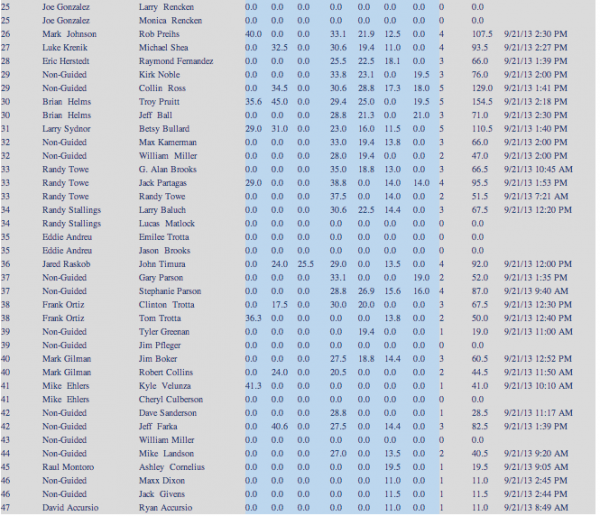
Tejera and I were enjoying a solid lead with six species and 170 points. Not too far behind us sat Brian Helms and Troy Pruitt with 154.5 points.
The bottom line was that if Tejera and I caught a bonefish, a thing that we had every intention of doing, we would more than likely seal the victory and put the opportunity to win out of reach for everyone else. However, if we didn’t catch the bonefish, we knew that 15.5 points would not provide a large enough margin for us to win based on first day points alone.
I believe the saying is: This shit’s chess, it ain’t checkers.
Sunday, September 22nd, 2013
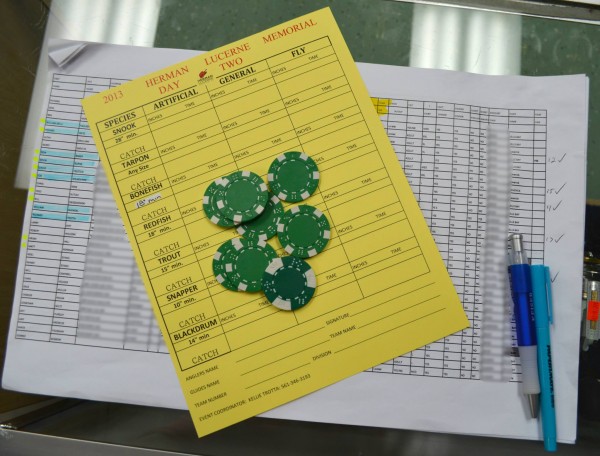
Ours was the only boat in the parking lot when we arrived at Don’s that morning. Another boat arrived a few minutes behind us, but the veritable showroom floor of cutting edge skiff technology that had graced the parking lot the morning before was nowhere to be found.
The conversations during check-in were short and clipped. There was no laughter. Nobody talked about fishing. The challenges awaiting us on the water were the sole occupants of our thoughts. And with the stakes much, much higher for everyone there certainly would be no tipped hands that morning. Nor was there any focus to be spared.
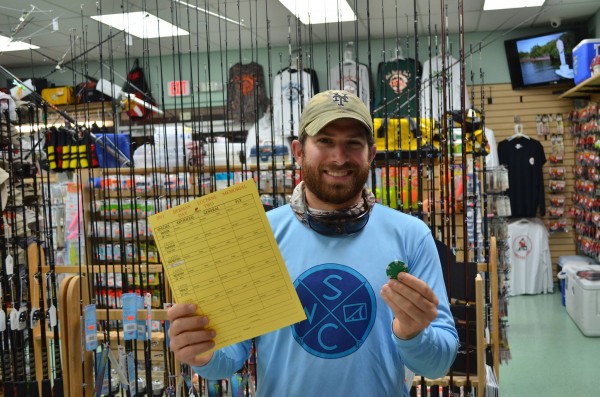
This is what a forced smile looks like.
*
There was no race to Flamingo through the quiet dark of early morning. When we arrived at the ramp the crush of skiffs all launching at once was absent. Our run through the starlit wee hours was a solitary one. The monotone of the outboard droning low and basic across the expanse of Florida Bay before returning to us in crackling echoes born of its collision with the mangrove monoliths secreted away in the perfect black.
Arrival at our first destination of the morning found the mosquitos particularly fervent and the small whoosh of gulping tarpon sounding off in the blind darkness surrounding us. By flashlight the 8-weight was rigged and laid by until the arrival of lines in.
The better part of our initial hour of fishing on Day 2 was trying. A ladyfish inhaled our perfectly manicured fly on the first cast. Taking it down to the pit of its throat and managing in the process to weave the leader into and out of an entire set of gill rakers. Fifteen minutes of surgery were required before the fly was successfully removed. Even then a pitiful shadow of its former self. Blind in one eye, flashless, and the weed guard akimbo.
An anemic orange glow began to build in the east and as color was lent to the world, so did it begin to reform in rangy lines out of the dark. With our sight returned to us were able to get eyes on the tarpon in their cavorting.
I began making casts at the fish as they showed. Casts that fell with leader and line still raveling. They fell too wide. Too close. I missed one hook set and then another.
I was clenching and clenching the cork of the fly rod when Tejera stopped the boat.
“Carlos. Take a deep breath. Calm down.”
I nodded. I pulled my buff down and spun my hat around to the back and tried to remember that over the years I’d caught enough tarpon to sink a Gheenoe and that feeding a fly to one more would be the least difficult thing I would do all day.
“Okay,” I said. “You’re right. Let’s go catch one.”
We poled 150 yards down the flat without seeing another tarpon.
What we encountered at the end of that fishless stretch was an embarrassment of riches. Silver everywhere.
Tarpon could be seen rolling by the dozens for a quarter-mile in every direction save from that which we had come. A shrimp hatch had occurred that morning or the evening before and the poons had descended upon it. Feasting on the tiny crustaceans in an orgy of shimmering scales and yawning mouths. The fragile crustaceans spraying a pale rain over the flat with each sortie run against them.
The tarpon were oblivious to our presence as Tejera eased the skiff into the melee.
“Wait for the right shot,” he said. “Then fuck him up.”
I looked off a few fish that rolled close, trying to find one with shoulders set a little further apart.
The fish I wanted was coming at me when he rolled. I made the cast. Three long, sliding strips and the fly disappeared in a rumble of bursting bubbles. I strip set the poon hard and three times, assuring that the thin wire hook had found flesh to grab. The tarpon leapt. Gills and scales rasping with the thin, dissonant clatter of hardware discarding into a coffee can. Sprinting away and then returning with the same haste. The fly line hissing as it ran through my fingers. The still water. Once more the tarpon leapt. The hook stayed.
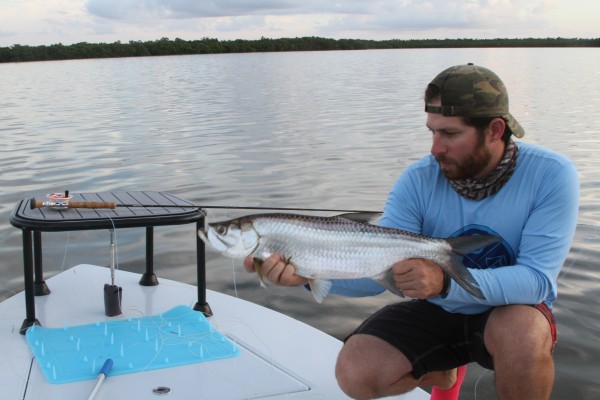
At 730am we put our last upgrade to the stick. At 27″ the poon gave us another six points on the scoreboard and enough of a cushion to remain in the hunt and to quite possibly come out on top if we or anyone else was unable to come up with a bonefish. Even though Tejera and I were fairly certain we’d be able to get tight on some chrome, we didn’t want to take any chances.
With such an abundance of happy tarpon directly in front of us, we would have been remiss had we not we stayed another fifteen minutes hunting for a slightly larger fish. We caught two more tarpon, but neither fish proved larger than the first. And just before 8am with the threadbare skirts of cloud scattered across the sky immolating before the newly crested globe of celestial fire smoldering at the horizon, Tejera steered the skiff away from the poons, gamboling about the tannic shallows, along a southerly course. Towards Bonefish. And Victory.
*
Abula vulpes. Fickle. Spooky. Neurotic. These attributes, to varying degrees, are inherent to all bonefish. Thus, as a rule, bonefish are always difficult to catch. Calling these fish complex would be to put it diplomatically. Furthermore, within the boundaries of Everglades National Park, the area where bonefish sneak is fairly limited. Such was the challenge of coming tight to our seventh and final species in the six and a half hours of fishing time that remained in the tournament. A very, very short list of places to hunt. And a mark that is literally scared of its own shadow.
The upside, however, was that ANY bonefish we caught would almost undoubtedly break the 18″ minimum required for a bonefish to be legally scored, as small bones don’t make many appearances in that part of the world. At least there was that.
Our plan was fairly simple. We would cover as much ground as possible in the time that remained, and every square foot of marl that we poled within range of would be scrutinized until our eyeballs burned against the salt air and we went snowblind before the molten gesticulations of the shallows in their shifting. Nor would anything be left to chance. No flash, no shadow, no unidentified shape sliding along through a bit of patchy grass, would be allowed to pass before our eyes without having a live shrimp presented to it.
*
After pushing onto the first flat, we were briefly hamstrung by a few false starts.
A houndfish found our shrimp on its return from a long cast at a vague form we saw resting at the edge of a wide pane of glare, and purloined bait, hook, and a few inches of leader. Not long after we retied a light-colored shadow slid into my periphery at a fair distance. I let a cast go and was, upon the shrimp alighting, immediately tight to small bonnethead shark. Though I must admit, there was a brief moment, before we saw it was a shark, where my breath caught and the blood ran hot through my ears. Another retie later and we were back at it. A few more minutes passed and Tejera was hunching on the platform and calling a fish at 11 o’clock. I couldn’t see it. For the life of me. I pointed with the rod the tip and Tejera tried to dial me in. I saw nothing. I searched from nine to three and found nothing but grass and a lazy ray. I threw up a hail Mary. As the shrimp raced back to earth I saw the swaying of a tail as it carried the fish Tejera had seen off of the flat.
It was a frustrating start. As we poled away from that first flat and towards the next one a pair of redfish swam idly before us. I looked on them with disdain. I cursed them.
*
Our first legitimate shot was at a bonefish that would have measured somewhere in the neighborhood of 30″. A fucking slob. It was at 1 o’clock, facing away and into the wind. 80 feet.
I saw the fish a little bit later than I would have liked. I made a terrible cast. The shrimp landed well wide of the bonefish and too far beyond him. By the time I’d reeled back up the fish had felt us and was engaged in that maddening behavior of swimming just hard enough to hover at the edge of my maximum casting distance. Tejera gave a hard push and I launched the shrimp again. The cast fell on target. Right in the bonefish’s wheelhouse. He just looked at it and kept going. As far as that fish knew there was an eighteen foot shark trying to creep on him.
*
Shot number two came about an hour or so later. A pair of fish popped up and were coming towards us on the left. Their line was bringing them parallel to us at a distance of 30 feet. Cars passing on the highway. I made the cast. The shrimp swept with the tide towards the bones. The bones came nosing their way along on the road to my shrimp. A collision course if you will. Then the bonefish swam underneath the shrimp and away to the south. Neither bonefish ever got eyes on the shrimp. It been riding too high in the water column for them to see it.
This was a lesson in tragedy. Or perhaps comedy. The line is an easy one to blur.
Tejera and I had only minutes before considered adding a split shot to the leader to help get the shrimp below the accursed houndfish that had been hassling us all morning, but had agreed instead to forego the extra weight as the flat itself was still particularly skinny and we didn’t want the shrimp getting buried in the marl.
This missed opportunity is a perfect example of why it is said that decisions are acts of violence. Because there is always a casualty.
*
A wide, silver flash at 12 o’clock. I made a cast. The shrimp, with split shot attached, settled. A fish bumped it. Bumped it again. I came tight. A houndfish, with my shrimp in its teeth, went skittering away off to the left. Wild head shaking ensued and the hound threw the bait. I retrieved the hook and set about peeling the small soupcon of shrimp tail still pinned to it from the barb. Then I looked up.
“Fuck.”
Four bonefish were coming in slowly at 9 0’clock.
Tejera saw them next.
“Grab a shrimp. Quick. Quick. Quick.”
I padded quietly and with as much haste as possible down to the transom. I snatched a shrimp from the livewell, threaded it onto the hook and got back onto the casting platform.
“Get it in front of them.”
I made a forty-foot cast and it landed on the mark. Tejera crouched and held the boat to against the pushpole. I sank into a half-sqaut. All four bonefish converged on the shrimp. The lead fish nosed the shrimp from the grass. The reflexive kick of the small crustacean trying to avoid its imminent demise shot up the braid. At this exact moment the fish in rear of the school, in no place to compete for the shrimp, looked up. Huge in his field of vision was us. The fish spooked. Swimming a crazed circle over the other fish and scattering them in a panic of slashing tails to the south, east, and west.
I looked back to Tejera hoping that he would give me some sign that the last instant had been a flight of deranged fantasy. That the bones were still there. Or that I had come tight to one and simply blacked out with euphoria when the eat occurred.
It was some sign that he gave me. Chin lowered and with each elbow resting atop a knee, his hands cradled his head and he was silent. We both were.
As an angler this was the most awful moment I had experienced in nearly a decade.
*
Tejera and I had spent the last twenty minutes filling the chill of his truck cab with the math and speculation of what might have transpired on Day 2 of the Herman Lucerne. We were halfway back to Don’s Bait and Tackle, feeling good and fairly certain that if nobody had been able to close out all seven species that we were in as good a spot as anyone to come out with Grand Champion, when the text came in from Tejera’s fellow guide Jared Raskob.
You get the bonefish?
No.
A few minutes passed before Raskob replied.
We got seven.
It was over. There would be no Grand Champion for us.
We would find out later that evening that the deathblow Raskob and his angler John Timura had struck against us and the rest of the HLM field came by way of a black drum taken on artificial.
With only seven minutes remaining to fish.
*
The 2013 HLM Results:
Major congratulations are due to Jared Raskob and John Timura for winning Grand Champion honors. These two fished an incredible tournament and came out on top of the heap in the most dramatic fashion possible. Black drum at the buzzer. Booyah.
Excellent work, gentlemen.
And a serious round of applause is also due to the rest of this years HLM field for absolutely crushing it. Look at some of the fish that were caught and the numbers that were put on the scoreboard. Pretty amazing catches made during a tough, full moon weekend. Bravo.
As for Tejera and I, we fished as hard as we possibly could have for those two days in late September. Even though we came up a little bit short of what we had set out to achieve, we finished the tournament without a single regret. And we put up a damn good showing too, finishing third in the Artificial division, second in the Fly division, and walking away with Top Male Angler and little bit of hardware.

But in the end, you can forget about all the fish that were caught or not caught. And you can set the awards on fire. Call it sentimental or cliché or whatever you want, but what matters most to me is that I was able to share the experience of fishing an amazing and challenging event, in one of the most beautiful places on earth, with a dear friend and a whole mess of other hopelessly addicted and talented captains and anglers. In fishing, friendship, camaraderie, and a love of the sport are paramount. All of the rest is inconsequential. It’s just stuff to lie about over whiskey and beer.
*
Monday, September 23rd, 2013
Tejera and I met the following morning at Homestead Bayfront Park on the heels of a particularly gnarly storm front. Despite our failure the previous day to get tight on a bonefish, we donned our rain gear and set out, undeterred, in search of retribution.
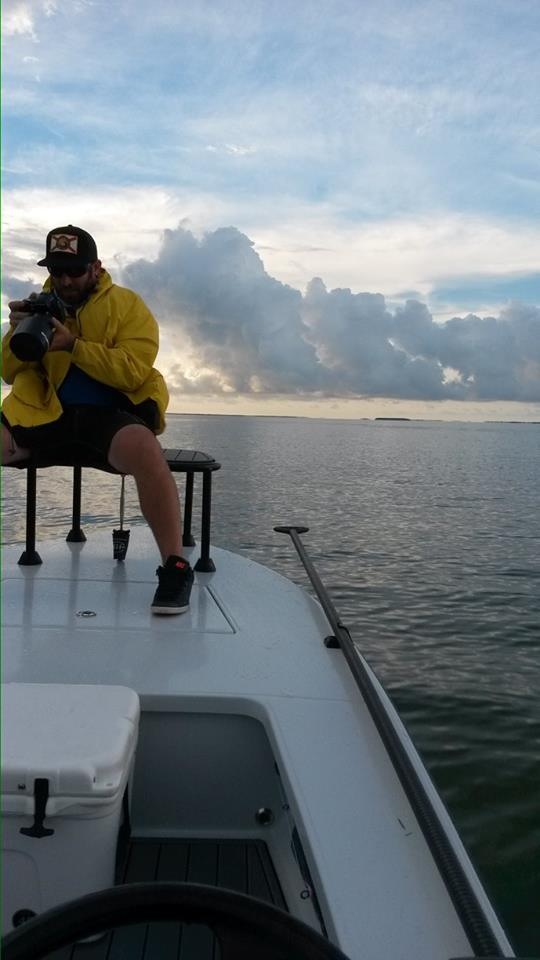
Most of the morning was spent joking about the certainties guaranteed to us under Murphy’s Law and reliving the pressures of the previous 72 hours. It also provided an opportunity for me to work on further dialing in some new camera equipment I had recently acquired.
Interestingly enough, what we did none of on our way to the first flat was talk or think about catching a bonefish.
It worked.
Less than thirty minutes had elapsed since I’d stepped onto the casting deck. The bonefish was working towards us across the incoming water. Tail rising above the sweeping brine as it tipped down into the marl to feed on some tiny morsel, then severing down beneath the water once more. Annular stirrings of the tide marking its progress.
I landed the shrimp a foot ahead of bonefish.
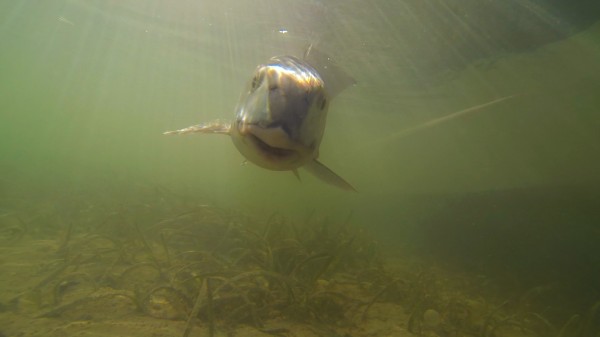
The slaty, punch blade tail stove the wide, limpid of sheets of flawlessly polished tidewater pulsing across the flat as the bonefish angled down to gorge on the shrimp. A single, heavy thump carried up the braid and the fish was off at a shot.
Thin sucking as the racing braid carved the water. A small roostertail firing in its wake. The high peal of the drag as braid vanished from the spool. Only a few wraps of the monofilament backing remained when I finally managed to turn the bonefish.
Battling the fish back to the boat, there was no fear of the hook coming unstuck, the leader parting, or any of the other tragic scenarios that typically befall prized gamefish once hooked. Just a lot of laughter and head shaking. A few short minutes later and we had the bonefish to hand.

Forty more minutes of fishing. That’s it. All the time we had needed to catch our bonefish. To put hands on that chrome torpedo a day late was bittersweet to say the very least. However, it felt damn good to get back out on the water the very next day, despite our failure to catch a bonefish when it counted, and put a hook in one. And if nothing else it meant the bonefish monkey was off our back for next years HLM.
We sent the bonefish on its way and got back to fishing. After all, I still had four hours before I needed to hit the road for Miami International and catch my flight back to reality.
For the next hour or so a vibrating pushpole and encroaching storms forced us to keep the rods stowed and to miss a good portion of the tide as we sought refuge from the imminent deluge. We managed to stay dry and once the storms cleared, what remained of the day was rather beautiful. Sunny, cloudless and calm. A few more shots at bonefish were afforded to us that day and on one flat a solid permit tailed just out of range. And in spite of our best efforts to sneak up on him, he was never seen again. Such is the way of permit.
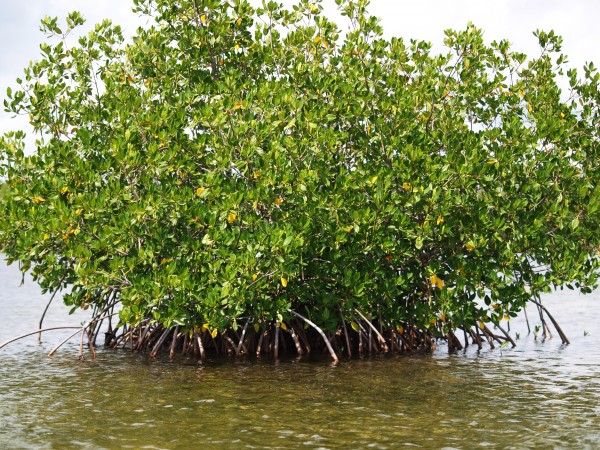
Shortly after 1pm Tejera and I called it and made our way back to the marina. We said our goodbyes and just before parting ways a unanimous decision was reached that the four days we’d spent grinding it out in the Glades and Biscayne Bay constituted, and with very good reason, our favorite fishing adventure yet.
And that at next years Herman Lucerne we are going to get all seven species. On the first day. Or at least try like hell to do so.
After all, a man has got to have goals.
___
Big thanks go out to the Herman Lucerne Memorial Board of Directors, Advisory Board, and Event Coordinator Kellie Trotta for putting on such an incredible event. It was an absolute pleasure participating in the tournament and I look forward to fishing it for many years to come.
Furthermore, the HLM is much more than just a fishing tournament, with all of the proceeds generated by the event being used to benefit Everglades National Park. As anglers, we’re very lucky to have an organization like the HLM around to create awareness and do all that they can to protect and perpetuate a resource as incredible and as valuable as the Everglades.
Check them out. For real.
Finally, an ocean of thanks go out to my brother-from-another-mother Capt. Steven Tejera for the boundless hard work and dedication that he brings to his skiff day in and day out. It is an absolute honor and privilege to share time on the water with him. I’ve said it here before and I will say it again. If you want to make the pilgrimage to Everglades National Park and absolutely hammer fish, you must call Steven. He is as good as a fisherman as there is in that part of Florida. Without a doubt. Call him.
Just don’t get any ideas about asking him to fish next years Herman Lucerne. Dibs.
Knot Tight Charters on Facebook
Last week I traveled for the first time to Montauk, NY. Fabled sport fishing destination and home to epic striped bass and bluefishing. Having really only saltwater fished in southerly climes for the majority of my life, it was a new and completely eye-opening experience to fish the fall blitz. I know I’m not reinventing the wheel when I say this, but Montauk certainly does boast an extraordinary fishery and it was a real pleasure to be able to enjoy it for a couple of days. I will have a super exciting and totally righteous report from the trip up on the blog in a few weeks. Until then, feel free to soak up all the delicious content from the rest of the SWC team!
-Baz

